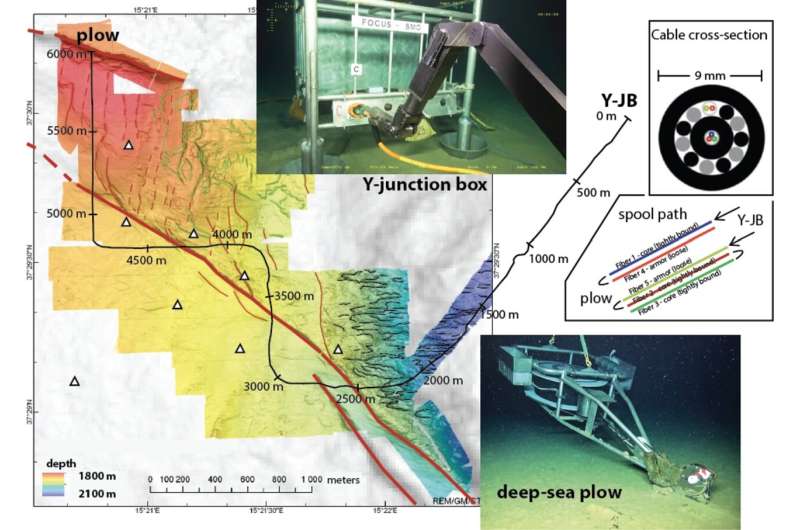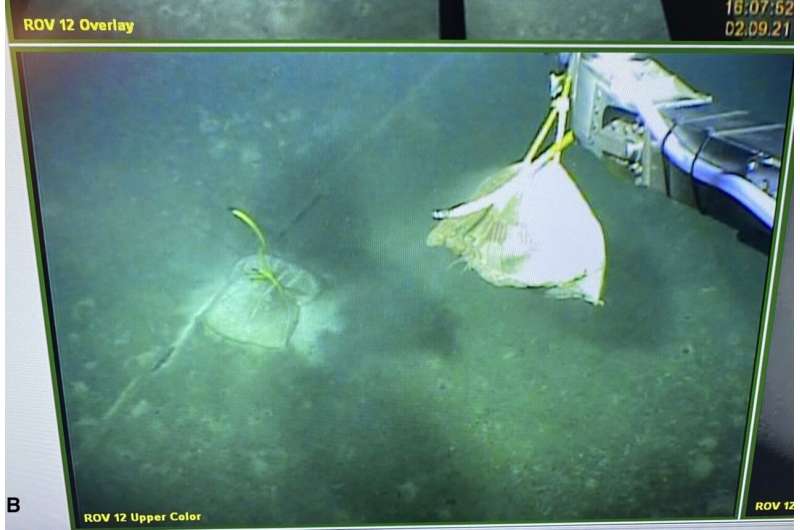June 13, 2023 feature
This article has been reviewed according to Science X's editorial process and policies. Editors have highlighted the following attributes while ensuring the content's credibility:
fact-checked
peer-reviewed publication
trusted source
proofread
Seismic monitoring lasers may be the future for protecting global communications cables

The depths of the oceans are home to a complex ecosystem of marine organisms, but also a vast network of cables spanning the globe that aid communications. Earthquakes and tsunamis can potentially damage these important cables. The Earth's surface is more than 70% water, which creates a challenge for scientists who monitor this seismic activity.
However, the cables themselves offer a potential new technique for monitoring seismic activity using laser light. A recent study by researchers at Geo-Ocean and their collaborators reported in Earth and Planetary Science Letters have used laser technology, termed Brillouin optical time domain reflectometry (BOTDR), to monitor the structural health of these cables in near real time. Typically, this technique has been used to monitor large engineering projects, such as dams and bridges. Applying this technology in a submarine setting means cables highly susceptible to damage can be identified promptly for repair.
The scientists used a remotely operated vehicle to deploy a 6-km-long cable to measure strain 2,100 meters below the sea surface. It was attached to an enormous 29-km-long fiber optic cable in order to measure earthquake activity offshore of Catania, Sicily. This involved firing a laser (comprising hundreds of thousands of pulses over two hours) through one end of the fiber optic cable and detecting the points at which the light scattered off imperfections, highlighting areas where the cable was deformed in some way.
Over 21 months, beginning in October 2020, they found that the cable experienced an average increase in length of 2.5 cm, which was attributable to deformation caused by tension where the cable crosses the North Alfeo Fault on the seafloor. This area is prone to strike-slip faults (where two tectonic plates slide past each other), although the study section experienced subduction of a narrow plate beneath the Ionian Sea under northeast Sicily, and resulted in strain reaching 500 m in both directions from the point of crossing the fault.

Further tests deployed 79 sand bags, weighing 25 kg each, at 120-meter intervals along the cable, which resulted in extension as the cable sunk into the soft sediments below and was stretched up to 4 cm. Importantly, this stretching was not limited to just the area where the sandbags were dropped, but actually impacted twice the length of the intervals. This is an important finding, as burial of communications cables beneath a heavy load, such as caused by moving blocks or sediment slumping during fault movement, strong bottom currents or turbidity flows (a water-sediment mixture flowing rapidly down a slope at speeds up to 20 meters per second), could have significant impacts on the ability of communications cables to withstand such tension and maintain their integrity.
Despite this there is positive news, as the elastic properties of the cable mean some of the strain dissipates over time; therefore, the cable has some potential to "correct" the damage and is thus less likely to break entirely.
The area of Italy in the study has experienced devastating earthquakes in the past, such as the 1693 event that resulted in 12,000 deaths in Catania alone, or the more recent 1908 earthquake where up to 82,000 people tragically lost their lives in the area known as the Calabrian Arc, of which Catania is a part. The novel use of the laser technology may mean that seismic activity could be identified in advance of an earthquake and allow time for planning strategies that could mitigate damage to life, infrastructure and our communications.
More information: Marc-André Gutscher et al, Detecting strain with a fiber optic cable on the seafloor offshore Mount Etna, Southern Italy, Earth and Planetary Science Letters (2023). DOI: 10.1016/j.epsl.2023.118230
Journal information: Earth and Planetary Science Letters
© 2023 Science X Network




















